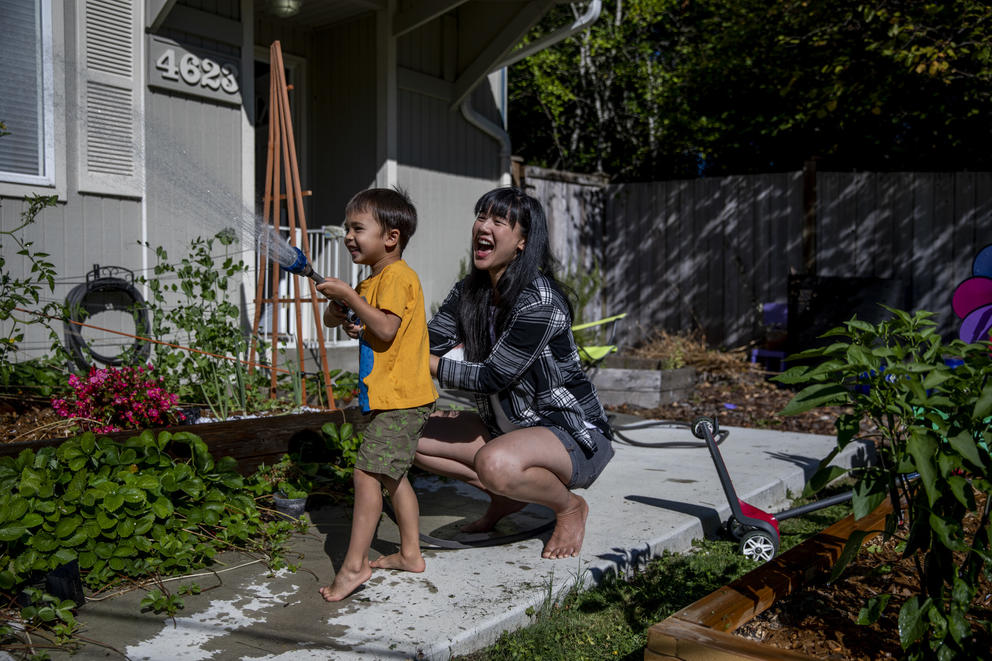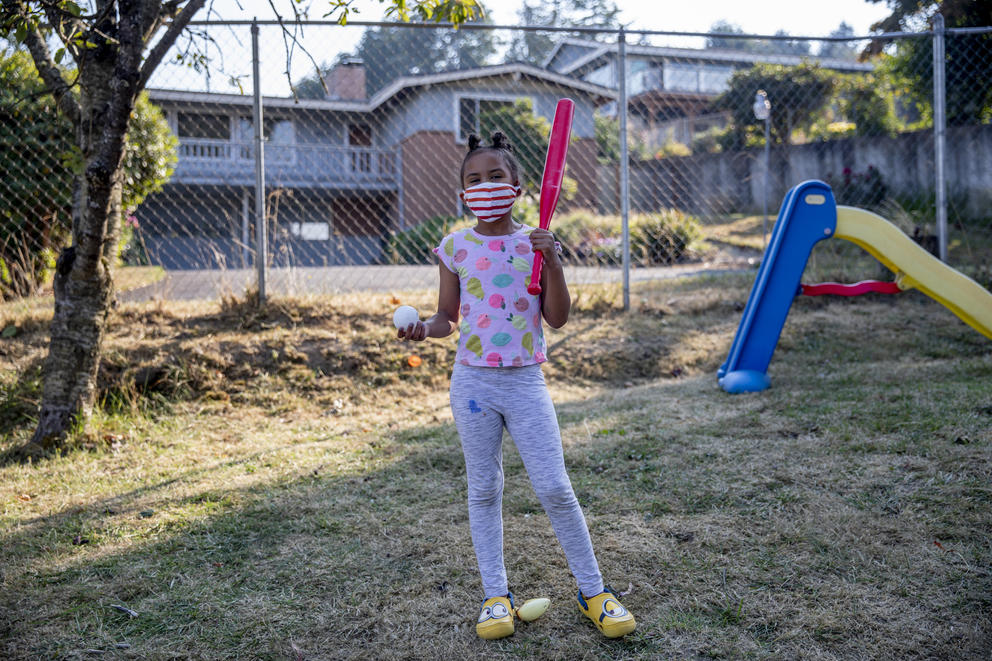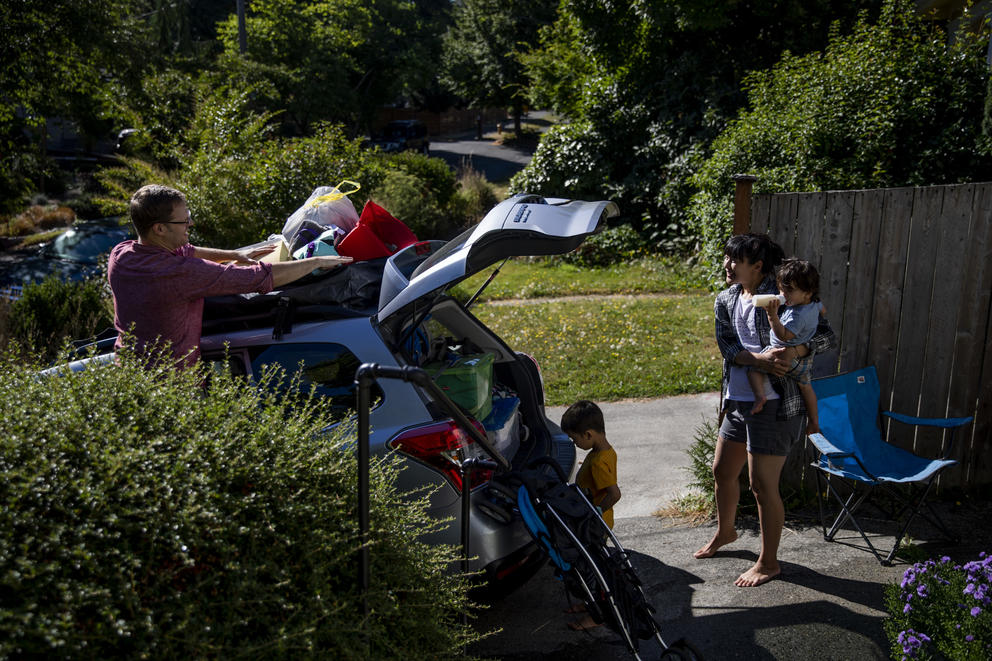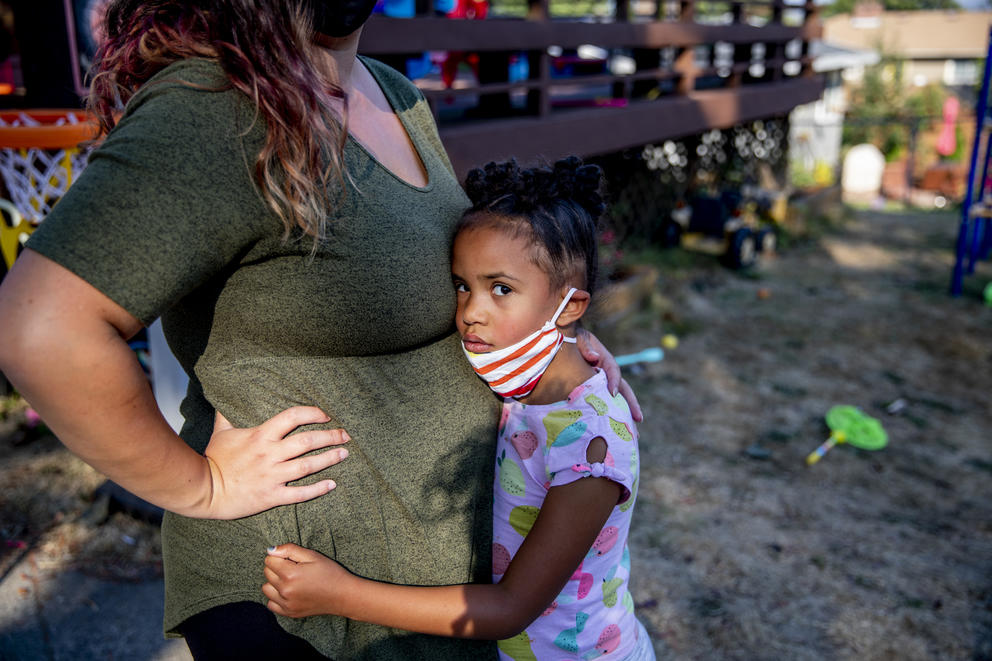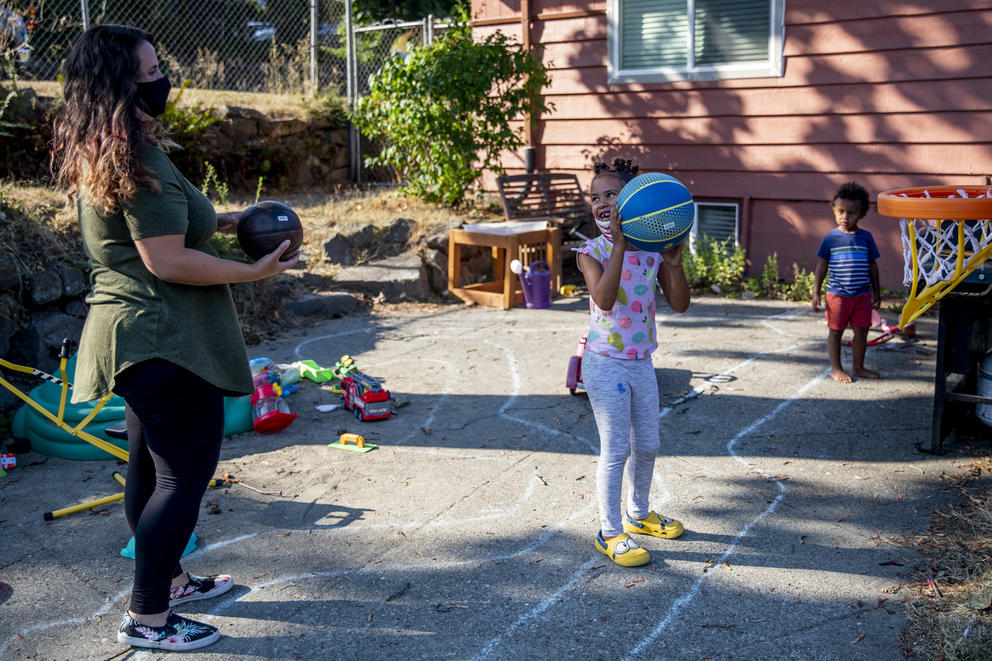“I was thinking, I can’t find work until I can get these kids back into some sort of child care or school,” said Liu, 37, who had been working at an environmental consulting firm. “I was absolutely overwhelmed by the child care problem — I did not see any way to look for a job.”
Liu’s child care facility is among the many that closed in Washington state during the early months of the pandemic. According to the state Department of Children, Youth and Families, about 1,000 child care programs closed temporarily between March and late August for pandemic-related reasons. Those closures affected about one-quarter of the state’s child care slots.
Some facilities shut down temporarily for a deep cleaning. Some closed because of exposure to the virus. And others closed because of declining enrollment, as more parents kept their kids home because of financial reasons or health concerns, according to Child Care Aware of Washington, which tracks child care availability.
After about a two-month closure, Liu’s child care provider reopened, but Liu still faced a difficult choice. Should she send her children back to day care, increasing their risk of catching COVID-19? Or should she stay home with them and keep them safe, while limiting her ability to work?
It’s a dilemma many parents are now grappling with across the country, said Kyra Miller, the state policy and outreach manager with the National Women’s Law Center. And, depending on what happens over the next few months, the nation’s already-strained child care system could emerge from the pandemic even more battered than before.
Heading into the pandemic, Washington state already had a significant shortage of child care options. According to a report the state Department of Commerce released last month, the state had enough licensed child care slots to serve only 41% of children under the age of 5.
The same report found that nearly 550,000 of children under 12 in Washington had no access to licensed child care, even though an estimated 61% lived in homes where all adults worked.
Now, the pandemic is threatening to close even more child care facilities, exacerbating the problem, said Deeann Puffert, CEO of Child Care Aware of Washington.
“My fear is that, as we come back, there won’t be the capacity to return to what was normal in the past,” Puffert said.
Child care providers across the nation share that concern. In a June survey conducted by the National Association for the Education of Young Children, about 40% of providers surveyed expected to close permanently if they didn’t receive more public assistance. The same survey of more than 5,000 providers found enrollment at child care facilities was down an average of 67%, dramatically reducing providers’ income and making it difficult for them to pay their bills.
While the CARES Act — the Coronavirus Aid, Relief and Employment Security Act that Congress passed earlier this year — provided $3.5 billion in grants to help keep child care programs afloat, that money fell far short of what was needed, according to a letter signed by more than 50 national organizations. Those groups are urging Congress to approve $50 billion more in relief to “ensure that we will have a child care system left to return to after the pandemic is over.”
Miller of the National Women’s Law Center said ensuring people can access child care is a crucial part of ensuring they can return to work when the economy reopens.
“We’re at this weird wait-and-see moment where we hope it is temporary, and we desperately hope they are able to come back,” Miller said of the child care businesses that have shut down. “But, we just don’t know.”
As of the end of August, state data showed that 18% of Washington’s child care facilities remained closed. Puffert said it’s possible some may never reopen.
Patty Liu and her son Everett, 4, water their garden outside of their Seattle home on Aug. 28, 2020. Liu got laid off at the end of March after starting a new job in January. Her children’s preschool closed in mid-March. When the day care reopened a few months later, Liu and her husband still worried that sending their children there could increase their risk of contracting COVID-19. (Dorothy Edwards/Crosscut)
New onslaught of pressures
In some ways, Cheryl Guilliatt-King was one of the state’s luckier child care providers. Early in the pandemic, she applied for and received grant money from the state and King County. That money helped her keep her in-home child care in Tukwila open in April, May and June, even as many of her families kept their children home, she said.
Now, however, that money is gone — and Guilliatt-King is facing new challenges.
One is the coming fall flu season, she said.
Because some flu symptoms resemble those of COVID-19, that could cause confusion and lead to more parents pulling their kids out of day care due to fears of infection, she predicted. That would hurt not just her bottom line, but also that of many families who need child care so they can work and earn a paycheck, she said.
“Everybody is going to get sick and they’re not going to know unless they go get tested for COVID,” Guilliatt-King said.
Then, there’s the weather. Guilliatt-King said one reason she thinks no children have gotten sick with COVID-19 at her small child care facility is because they have been spending so much time outside.
But what about when summer is over, and keeping kids outside in autumn and winter becomes less practical?
“We’re concerned about moving everything indoors,” Guilliatt-King said. “It seems like they are healthier if they are outside.”
Guilliatt-King is also worried that struggling families won’t be able to afford to pay for child care anymore — especially since laid off workers no longer receive an extra $600 a week in federal unemployment benefits. Other families may choose to continue to keep their children at home to avoid illness; either way, Guilliatt-King would lose income.
In neighboring Skyway, Jenna Shames already has had to close her in-home preschool once this year — and thinks she may have to do so again.
“The decision was kind of made for me by our families,” Shames said of her decision to shut down March 10. “As the cases started rising, they pretty much said they weren’t comfortable coming, which I totally understood.”
For Shames, it was a particularly tough blow, since she had just opened in January. She had hoped to recoup some of those startup costs over the course of the year, which looks less likely now.
Shames reopened in July, with much lower enrollment. She, too, moved her classroom outdoors, but isn’t sure how that will work when the rainy season comes. She is looking at buying a banquet-sized tent for her backyard and maybe some outdoor heaters, so she can continue to hold lessons outside.
Yet it is her own child’s schooling that could make it impractical for her preschool to remain open, Shames said. Her 5-year-old daughter is starting kindergarten this month and will be doing remote lessons at home, while Shames attempts to run an in-home preschool.
“It’s kind of like two different curriculums happening at the same time,” Shames said. “If she has any computer problems, we have to stop what we are doing so I can work on those computer problems. And I don’t know how she would feel if we are having fun outside while she is stuck on the computer inside.”
As a mother of two, Shames had wanted to open her own preschool partly because it had been too difficult to find care for her own children while working in the low-paying child care industry. She had hoped to employ other early childhood educators who were also parents and may have faced the same struggle.
Join us: We're hosting a free, live event Sept. 23 to talk about this series. See the details.
But now she may end up abandoning that dream and applying for other jobs, like in the accounting field, which she thinks she could do more easily from home while managing her daughter’s education.
“I picked the worst profession,” Shames said ruefully this month.
Child care deserts could get worse
Puffert, the CEO of Child Care Aware of Washington, said many areas, including South King County, already had “a huge lack of care” even before the pandemic. If providers like Shames and Guilliatt-King close, it would leave families even fewer options.
“There were child care deserts before, and there are deserts now — and, many times, those are in areas where there are more essential workers and more low-income families,” Puffert said.
Those essential workers are often in even greater need of child care, she said, because they may have jobs that don't allow them to work remotely.
“They can’t Zoom into these jobs, necessarily,” Puffert said.
A look at child care closure data reveals some of the state’s most impoverished counties are also some of the ones losing the highest percentage of child care slots.
In Whitman County, where about 27% of residents live below the federal poverty line, closures had wiped out nearly 40% of the county’s licensed child care slots as of Sept. 1. That’s according to Child Care Aware of Washington, a division of which has been named the state’s official Child Care COVID-19 Communications, Response and Referral Center.
Pacific County, meanwhile, lost more than half of its child care capacity, according to the nonprofit. As of 2018, 17.4% of the coastal county’s population lived in poverty. That’s significantly higher than the statewide poverty rate of 11.5%.
Kittitas and Cowlitz counties have lost about one-third of their child care slots to closures. Both have among the highest poverty rates among Washington’s 39 counties.
Some counties with large Latino populations are hurting, too. In Yakima County, for instance, 38% of licensed child care slots were closed as of Sept. 1, according to the data from Child Care Aware. As of 2018, the median household income in Yakima County was $49,871 — about $20,000 below the state’s median income. About half of the county’s population identifies as Hispanic or Latino.
Franklin County similarly has seen 40% of its child care slots go away as providers have shut down. Franklin County’s population is roughly 54% Hispanic or Latino.
Both Franklin and Yakima counties were hard hit by outbreaks of COVID-19 over the summer.
Now, families in those communities are facing another round of hardship — the financial kind — as they lose the de facto child care provided by K-12 schools, Puffert said.
“Essentially, going to school plus the bus ride both directions can frequently provide you with seven hours of free child care, for lack of a better word,” Puffert said. “And now, that is all going away.”
Lisa Brown, who directs the state Department of Commerce, said access to child care is, in many ways, an equity issue.
Many of the people working in child care are women of color, Brown noted. So, when child care facilities shut down, women of color bear a disproportionate share of the job losses.
Women also tend to assume a greater share of child care responsibilities at home, which means their ability to work is affected the most when child care is unavailable, Brown said.
According to the recent child care report released by the Commerce Department, nearly one in five parents surveyed turned down a job offer or promotion because of child care issues. That happened even more often among Black and Native American parents, the report found.
While about half of unemployed parents said child care issues hindered their ability to work, the problem was more common among women than men. Fifty-one percent of unemployed female parents said child care was a barrier to their finding a job, compared with 41% of unemployed male parents.
Given how a lack of access to child care disadvantages women and people of color to a greater degree, Brown said it’s important for the state to take action to improve the system. That’s true now more than ever, as the state works to recover from the pandemic, she said.
“With respect to economic recovery, I honestly can't think of anything more important than investing in childcare,” Brown said.
‘Navigating through a fog’
Liu, the mother of two from South Seattle who was laid off, knows things could have gone worse for her family. She was able to get unemployment relatively quickly, including the additional $600 a week in federal benefits that were available through July. She and her husband still have their house.
Yet Liu worries about families that are in an even worse position — who are struggling not just with child care costs, but also with paying for rent and groceries.
“My heart hurts thinking about the people who were struggling before this started, and then the pandemic hit,” Liu said. “I don’t even know what they’re doing. … Obviously, the system is broken.”
Ross Hunter, who leads the state’s Department of Children, Youth and Families, agrees.
In an interview this month, Hunter called the child care system “a dysfunctional economy,” primarily because what young families can afford to pay for care is “lower than the cost of actually paying people to run the business.”
The child care system “was not functionally stable prior to the pandemic,” Hunter said. “And the pandemic is making it worse.”
Earlier this year, Hunter’s agency intervened to help some of the child care providers that serve low-income families.
In the past, the state subsidized those providers based on how many children actually showed up for child care each day. Earlier this year, however, state officials switched to paying based on enrollment, instead of attendance. That meant that, even if parents kept their kids home for weeks at a time, the child care providers still got paid.
Changing that policy effectively increased funding for the state’s child care system by tens of millions of dollars, Hunter said. It also ensured that many child care providers serving low-income kids didn’t go out of business.
But with the state facing a budget crisis of its own, money is running short. The enrollment-based payments that helped sustain many child care providers ran out in August, Hunter said.
The state pushed out about $29 million in federal dollars earlier this year, which helped about 3,600 child care providers, but that money is long since depleted. It isn’t clear when — or if — additional stimulus money might be forthcoming.
As of this month, child care providers also are figuring out how to navigate new guidance from the state Department of Health. The guidelines say that child care programs with groups of more than 15 children need to split the children into two groups and limit those two groups of children from interacting. That could create new difficulties for child care providers in terms of staffing and physically dividing up their space, Hunter said.
Underlying it all is uncertainty surrounding whether the closure of K-12 schools will boost child care enrollment, solving some of the industry’s financial problems — or, whether it will cause demand to skyrocket, fueling an even bigger child care crisis.
So far, many more parents seem in need of care for their school-age children this fall than they did in the spring, said Norma Lobo, who supervises Child Care Aware of Washington’s family resource center, which helps families find care. In the past month, Lobo said the call center has been fielding about 75% more inquiries from parents looking for child care, compared with the months of May, June and July.
The volume of calls began to skyrocket the week of Aug. 10, when some school districts began releasing their schedules for teaching remotely in the fall. Lobo said she thinks more calls poured in during the month of August than when schools first shut down in March.
While Hunter’s agency is working to help establish additional child care slots in empty school buildings and through community programs, it’s unclear whether those efforts will be enough.
“The answers to all these questions are completely unknown,” Hunter said this month. “We’re navigating through a fog.”
Taking the risk
After Liu’s child care provider reopened, she and her husband initially decided to keep their kids home for safety reasons. For a few months, they paid one-third of their normal tuition fee — about $1,000 per month — to keep their two children’s spots in day care, even though they weren’t sending them there.
By August, however, it became clear the COVID-19 crisis wasn’t going to just fade away. That left Liu and her husband facing yet another difficult decision: Should Liu, who has a master’s degree, give up on returning to work and become a stay-at-home mom?
That was never what Liu had envisioned for herself — but, if it would save money and help keep her family healthy, maybe it was worth it, she thought.
“My husband and I had the talk, and I said, ‘OK, let’s pull them out and I will be a full time stay at home parent,” Liu recalled. “And he said, ‘Your mental health is more important. I think we need to take the risk.’ ”
The family decided to send their children back to child care this month, so that Liu could begin searching for work again. She worried her career would suffer otherwise.
While Liu and her husband have already made their difficult choice, they still sometimes feel guilty about it.
“You need to be able to work, but you’re sending your kids into a day care with other families, and opening yourself up to the risk of infection,” Liu said. “It’s a really hard balance to hit.”
“...That guilt — I feel it never goes away.”



